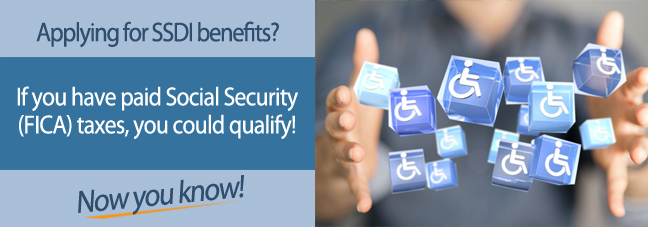If you have a disability that prevents you from working, you may be eligible for Social Security disability benefits. The Social Security Administration determines if you are financially and medically eligible to receive these payments, which help pay medical bills and living expenses.
Social Security Disability Insurance is for disabled persons who have been in the workforce for a significant amount of time. This is because SSDI is funded by taxpayers through the Social Security Trust Fund.
FICA Taxes and SSDI Funding
When you work for an employer, you and your employer pay FICA taxes that go into this trust fund, which is then used to distribute benefits. Or, if you work for yourself, you pay both the employee’s and the employer’s tax. That way, you contribute to this entitlement that can really help you if you’re now suffering a disability.
Your household income level doesn’t matter, so you can still qualify for SSDI if you have a spouse who is working. There are still conditions, however.
In order to qualify for SSDI, you need to have worked long enough to have contributed a specific amount to the Social Security system through FICA taxes. The Social Security Administration calculates this using work credits.
Work Credits and SSDI
Your earnings are converted into work credits. Every year, the dollar amount needed to earn one work credit is re-calculated. In 2016, 1 Social Security work credit is equal to $1,260 in earnings. You can earn a maximum of 4 work credits if you earn $5,040 throughout 1 year.
You do not need to have paid a large amount to receive credit for paying into Social Security. What’s more important is the length of time you have been working. The number of years that you have worked determine your eligibility for disability, and the rules differ for people of different ages. For example, if you are older, you will need more work credits to qualify for benefits. This means you will have worked a longer period of time.
There are two tests you need to take involving work credits: The Recent Work test, and the Duration of Work test.
The Recent Work test is broken down into 3 age brackets, and depends on when you became disabled.
- 31 or older: You’ll need to have worked 5 out of the last 10 years to pass, or earned 20 credits in the last 10 years before you became disabled.
- Between 24 and 31: You need to have worked at least half the time since turning 21. For example, if you are 25, you’ll need to have worked at least 2 years, which is half the 4 years between being 21 and 25. This would amount to 8 work credits.
- Under 24: You’ll need to have worked 1.5 years in the last 3 years, or earned 6 credits.
The Duration of Work test is similar to the Recent Work test, but is based on how long you have worked overall rather than how long you worked right before you became disabled. This test takes the specific age at which you became disabled and matches it to the number of work credits you’ll need to qualify for disability. For example, if you are 46 at the time of your disability, this test requires that you’ve earned 24 work credits, or you’ve worked for 6 years.
Getting Help with your SSDI Claim
It’s strongly advised to seek the help of a disability benefits advocate or attorney throughout the application process. A lawyer will help you maximize your chance of success, and can also help you appeal if your application is denied.
